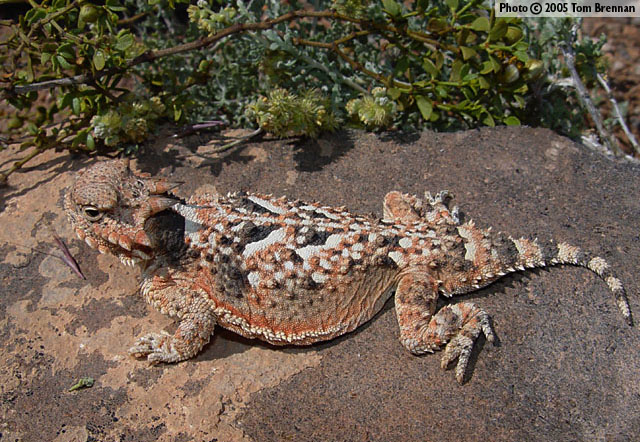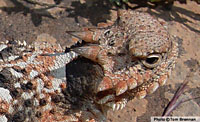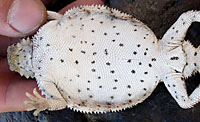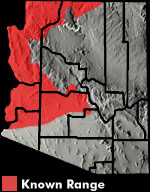Online Field Guide to The Reptiles and Amphibians of Arizona



Mohave County, AZ
 Mohave Co., AZ |
| DESERT HORNED LIZARD Phrynosoma (Doliosaurus) platyrhinos |
|
|
DESCRIPTION: A medium-sized (up to about 95 mm or 3.75″ from snout to vent), exceptionally flat and wide lizard. Thick, spike-like scales project from the back of the head. The two central head spikes (occipital horns) usually project nearly straight back (not back and up) and are noticeably longer than the other spikes. The bases of the occipital horns are not in contact with one another. Several isolated, pointed scales project from the back. Each lower side of the body is edged with a single fringe of enlarged, pointed scales. A row of enlarged, pointed scales projects from each side of the throat. Base coloration is tan, gray, or brown and usually matches the soil on which the lizard lives. The lower edges of the body are often infused with salmon, peach, or orange coloration. A pair of large dark blotches marks the neck and the back is often adorned with paired dark linear blotches or wavy bars. The rear of edge of each body blotch is often outlined with white or cream. In southern Arizona specimens the underside is often heavily flecked with black. In northern Arizona specimens black ventral-flecking, when present, is usually restricted to the posterior venter. The similar looking Goode’s Horned Lizard has sparse dark flecking that is usually restricted to the anterior venter and throat and its occipital horns project UP and back. The Desert Horned Lizard’s single fringe of scales on each lower side of the body and lack of a dark dorsal stripe distinguishes it from the similar Flat-tailed Horned Lizard. The bases of the occipital horns of the similar looking Regal Horned Lizard contact one another. DISTRIBUTION: This lizard is distributed across our states western deserts north of the Gila River at elevations ranging from near sea level along the Colorado River to about 6,500’. HABITAT: In Arizona the Desert Horned Lizard inhabits Sonoran, Mohave, and Great Basin desertscrub communities and the lower reaches of Interior Chaparral and Great Basin Conifer Woodland. It is usually encountered in relatively flat, open, areas with sandy or loamy soil and is less frequently encountered on rocky bajadas and foothills. BEHAVIOR: This diurnal ground-dweller is most active in the morning and evening. It seeks shelter from the high mid-day temperatures by burying itself in the soil or retreating into an existing burrow. When encountered it is more likely to run than our other horned lizards but it often stops under the nearest bush. When captured it may inflate itself by gulping air, poke with the horns, and flatten the body into a disc shape. DIET: The Desert Horned Lizard feeds on ants and a variety of other insects including beetles and the larvae of moths and butterflies. It also feeds on a variety of spiders and some plant material. REPRODUCTION: One or two clutches of eggs are laid in spring and summer. Clutch size ranges from 2 to 16 eggs. By Thomas C. Brennan
Brennan, T. C., & A. T. Holycross. 2005. A Field Guide to Amphibians and Reptiles of Maricopa County. Arizona Game and Fish Department. Phoenix, AZ Degenhardt, W. G., Painter, C. W., and Price, A. H.. 1996. Amphibians and Reptiles of New Mexico. University of New Mexico Press. Albuquerque. Mulcahy, D.G., A.W. Spaulding, J.R. Mendelson III, and E.D. Brodie jr. 2006. Phylogeography of the flat-tailed horned lizard (Phrynosom mcallii) and systematics of the P. mcallii-platyrhinos mtDNA complex. Molecular Ecology. Stebbins, R.C. 2003. A Field Guide to Western Reptiles and Amphibians, Third Edition. Houghton Mifflin Company, Boston, MA. |
|
Visit Partners in Amphibian and Reptile Conservation:


HOME
Copyright © 2023, Arizona Game and Fish Department. All rights reserved.
If you make use of the textual contents of this site in reports, publications, etc. please cite and credit the author(s) and photographer(s). All photos on this website are copyrighted. However, those found in the species account section may be used for any noncommercial scientific, educational, or conservation purposes provided that photographs are not altered and continue to bear the copyright symbol and name of the photographer. Please contact the photographer regarding commercial use of copyrighted photographs.











